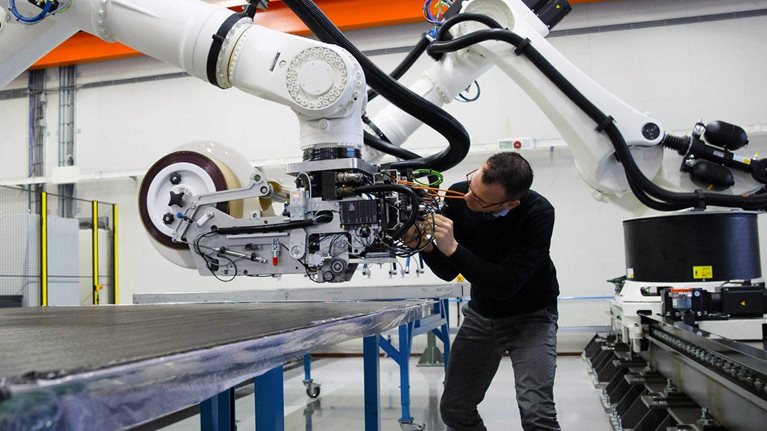Technology experts and economists are engaged in a growing debate about the effect of automation technologies in the workplace. Some “techno-pessimists” are concerned about the mass destruction of jobs, while “techno-optimists” see considerable productivity gains for the economy that will in turn help create new work opportunities. Technology in the past has tended to create more jobs than it destroys, at least in the long run. Could this time be different?
In this video, one in a four-part series, experts from academia and industry join McKinsey partners in a discussion of key issues about what automation may or may not change. The interviews were filmed in April at the Digital Future of Work Summit in New York, which was hosted by the McKinsey Global Institute (MGI) and New York University’s Stern School of Business.
Interviewees include NYU professors Arun Sundararajan and Vasant Dhar; Allen Blue, a cofounder of LinkedIn; Carl Camden, former CEO of Kelly Services; Stephane Kasriel, CEO of Upwork; McKinsey senior partner Katy George, and MGI partners Michael Chui and Susan Lund, who convened the summit together with professor Sundararajan.
Other videos in this series include:
- Skills that will count in the future
- The future of the 9-to-5 job
- What are the policy implications of automation?
Interview transcript
Susan Lund: With today’s technology, roughly half of the tasks that people do can be automated. That’s a staggering figure. But just as interesting, and maybe even more important, is that only 5 percent of jobs can be entirely automated. What it means is that, increasingly, all jobs are going to be affected. The way we work is going to shift over time as machines and machine learning and artificial intelligence start to take over some pieces of what we do. That will require people to adapt and change. And jobs, occupations as we know them today, will shift.
Arun Sundararajan: There are two main dimensions to how technology is changing work. One is that a lot of what humans used to do is increasingly being done by machines: robots, cognitive machines, simple software on your computer. The other side of it is digital technology is changing how we organize work. It’s taking us from fulltime employment, which was the predominant way of earning a living in the 20th century, toward a wide variety of non-employment work arrangements. What’s exciting and scary at this point is the confluence of these two forces.
What does workplace automation mean in practice?
Michael Chui: It’s clear from our research, but also just looking at history, that people increasingly, over time, will have to be complements to the work that machines do. Work side by side or work with machines. We’ve certainly seen this in history, in all kinds of places. Everywhere from the farm, where we now have gigantic machines that help harvest and sow crops, to being in an office environment, where there’s work that we used to do by hand or by calculator and now software helps us do it, whether it’s spreadsheets or word processors or even more sophisticated analytics. Going forward, we’re going to see more of these technologies which involve robotics or artificial intelligence, again, working side by side with human beings. Even if you’re on a shop floor or a factory floor, you’re seeing these robots, which are now safe for humans to work alongside. Whereas traditional, industrial robots are confined to cages because they’re incredibly dangerous machines.
Katy George: What I think it will mean in practice, first of all, is that many jobs will change dramatically. Some of the tasks we do today, we’ll be able to do in a much richer way because we have the benefit of automated support, much more insightful data analysis, real-time, et cetera. And it will mean, in some cases, that the job designs themselves will completely change and new jobs will be created to leverage all of the new technology opportunities that we have.
Is this time different?
Vasant Dhar: In general, I tend to be optimistic about human creativity and ingenuity. But I think this time around, we’re facing some really severe challenges. People have made the case that we’ve been worried about this previously and we needn’t have worried because new technologies have created new opportunities for human beings. But I worry that this time might in fact be different because we haven’t had intelligent machines in the past that we could trust with making decisions. That was in the domain of human beings. Machines assisted us. They helped us. But it’s different this time. And it’s going to be very challenging.
Stephane Kasriel: This is not the first industrial revolution. That’s why we call it the fourth. Historically, what we’ve seen is, yes, technology changes are destroying some jobs. But net-net they have created more opportunities, more jobs than they have destroyed. So usually there’s a short transition period which can be very difficult for some people. That’s why we built a safety net to allow people time to transition. Or if they can’t transition, give them a place to retire. It seems like this transition is not going to be fundamentally different from others.
Carl Camden: Robotics and automation as well as supply chain management have already transformed the work place. Every year fewer and fewer people work in jobs and more and more people work in gigs. That trend is irreversible. It just happens that automation, the rise of apps and so on, is speeding it up today. But it was inevitable that the jobs model was going to collapse.
Should we be pessimistic or optimistic?
Susan Lund: No longer do bank tellers hand out cash to customers, because there are automated teller machines. There’s one example. But has bank teller employment gone down? No, not in the United States. There are as many, and in fact more bank tellers, as there were when the ATM machine was first introduced in the 1990s. But they do very different things. They’re involved in selling customers other types of financial products, and they’re doing what we call higher value added services.
Alan Blue: We have no idea what the future of work really looks like. There are some threads we understand, but we really won’t know. So the most important thing for us to do is to build a system which allows us to be immediately responsive to changes that exist in the workforce.
Michael Chui: One thing that we should be worried about is whether we can adopt automation quickly enough. What we know is, because of demographics, because of aging, we simply don’t have enough workers, won’t have enough workers going forward, to have the type of economic growth that we want. To be able to continue to grow GDP per capita for countries, whether they’re developed or developing, to become more prosperous over time. For that to happen, we actually need the machines working alongside human beings. That means, in order for the economy to grow, we need to make sure that we develop and adopt all of these technologies and make sure that people are working so that the next generation will have better lives than we do. Other things that we might worry about? For certain, these technologies are going to displace human labor. They’re going to start doing things that people used to do. And what’s incredibly important again, number one for the individual workers because they need to be able to have meaningful work, but secondly, even for the overall macro economy, we need to be able to redeploy that labor. We talk about mass redeployment rather than mass unemployment. That’s a tremendous challenge. How do we make sure that we find new things for people to do, be able to pay them to do it, and also retrain them so that they can do these new activities?
For more details of the conference proceedings and videos of the full panels, please visit the Digital Future of Work Summit site.


